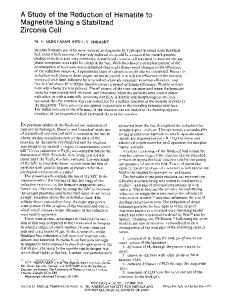Hematite single crystal reduction into magnetite with CO-CO 2
- PDF / 1,223,050 Bytes
- 7 Pages / 603.28 x 783.28 pts Page_size
- 57 Downloads / 330 Views
I.
INTRODUCTION
THE first step
in the reduction of iron ores, the transformation of hematite to magnetite, has given rise to a great deal of work. However, their industrial backgrounds have often motivated previous authors to carry out experiments with sinter or pellets, obtained from ore or from hematite powder, and with a highly reducing gas corresponding, at equilibrium, to wustite or iron. Under such experimental conditions, many chemical engineering parameters play an important role, and it is difficult to derive the true fundamental trends of the transformation hematite to magnetite. This is why we have chosen to use hematite single crystals, prepared in controlled conditions, and to investigate their reduction into magnetite, in order to clarify several features, for instance the transition from dense to porous magnetite, which has given rise to severe discrepancies among previous authors.
II.
LITERATURE
Only those papers reporting on single crystals or dense hematite will be reviewed. There are two main categories of hematite single crystals: they may be natural, or prepared in the laboratory (most often with a flux). For instance, Unal and Bradshaw I used ore particles, selected in the range 250 to 350/~m, which are generally either crystals or blocks of small crystals bound by a silica film. Likewise, Hayes and Grieveson 2 reduced ore particles of 45 to 63/~m. On the other hand, Swann and Tighe 3 dealt with bigger crystals, as also did Bessi6res 4 with crystals from Elba Island, and Sayama 5 from Hokkaido, or Beaulieu et al. 6 from Lac Jeannine. M. ET-TABIROU, formerly Graduate Student, is Professor at Faculty of Sciences, Kenitra, Morocco. B. DUPRE, Charg6 de Recherche, and C. GLEITZER, Directeur de Recherche, are with Centre National de Recherche Scientifique, Laboratoire de Chimie du Solide Minrral, Facult6 des Sciences, Universit6 de NANCY I, France. Manuscript submitted November 25, 1985.
METALLURGICALTRANSACTIONS B
Other workers have prepared dense samples as plates, like E1 Moujahid 7 or Geiger et al.,8 as cylinders like Walker and Carpenter 9 or Khalafalla et al., ~~ or even microspheres (< I0/zm) like Heizmann et al. l~ The samples are usually treated with CO-CO2 or H 2H:O and their weight changes are recorded with a thermal balance; the party or totally reduced samples are also examined with the SEM technique and optical microscopy for surface and cross-section features to be revealed. A few papers 2'3'7 also report continuous observations with transmission electron microscopy2 or hot stage optical microscopy. 3'7 Besides the kinetic data, which will be discussed below, the main peculiarity is the existence of dense lamellae of magnetite which grow inside the hematite matrix along crystallographically specified directions. This topotactic behavior has been pointed out and investigated by several workers 2'9'~H6 who established the relationships between the 2 lattices; it is sufficient here to keep in mind the existence of an oriented and semi-coherent growth of magnetite inside the origi
Data Loading...











